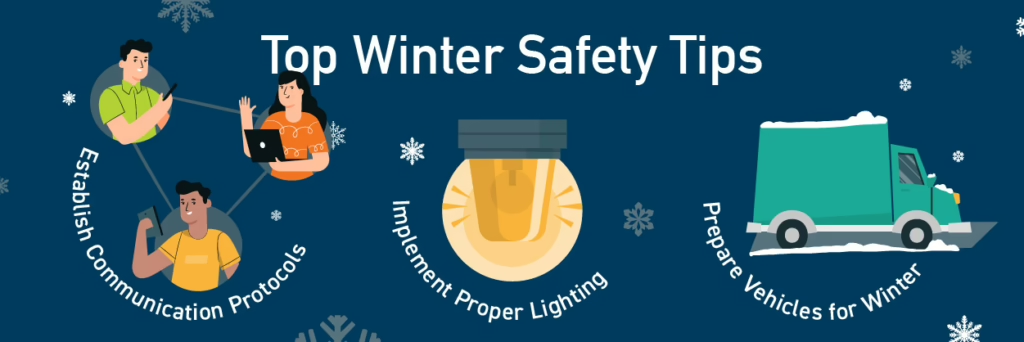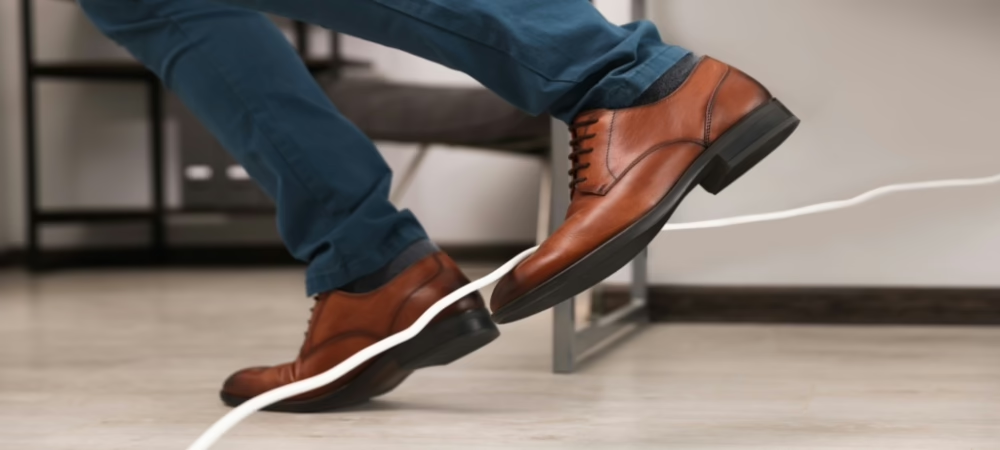Protect Your Employees in Cold Weather
Winter safety isn’t just about snow – it’s about preparing for the risks that cooler weather brings, regardless of geography. To help identify cold weather risks and keep employees safe this season, we’re sharing our top winter safety tips.
While over 41% of weather-related workplace fatalities are caused by ice, snow and cold weather, warm climates can still introduce winter hazards such as cold stress, rain-soaked surfaces and storm-related risks. It’s important for employers to have proactive cold weather safety measures in place.
Let’s jump right into our top tips for winter safety!
25 Winter Safety Tips
1. Develop a Winter Safety Plan
Your winter safety plan is essential to ensure business continuity and employee safety during seasonal challenges. Include specific protocols for dealing with cold weather hazards such as freezing temperatures or wet surfaces. Your plan should also outline responsibilities for handling emergencies like power outages and winter storms. Regular drills help employees understand what to do when a winter storm warning or winter storm watch is issued.
2. Stock Up on Winter Safety Supplies
Prepare for seasonal hazards by equipping your workplace with essential supplies. For wet floors or rainy weather, keep traction mats, umbrellas and non-slip footwear available. If extreme weather is expected, emergency kits should include items like blankets, flashlights and personal protective equipment (PPE). Stockpile backup supplies such as power banks to address potential power outages during severe winter weather events.
3. Implement Proper Lighting
With shorter daylight hours during winter months, ensuring adequate indoor and outdoor lighting is critical to reducing hazards, as low lighting and poor visibility are a common cause of slips, trips and falls. Use motion sensors for high-traffic areas and emergency lights in case of power loss. Adding extra lights in parking lots and entryways increases safety and helps prevent trip hazards in low-light conditions.

4. Inspect and Maintain Heating Systems
Even in warmer areas, heating systems must function properly during colder months to avoid cold stress, a condition caused by prolonged exposure to cold temperatures. Schedule regular inspections of HVAC systems to ensure they can handle the drop in temperature and provide adequate warmth. For regions experiencing occasional freezing temperatures, keep portable heaters on hand for extra warmth where necessary.
5. Provide Personal Protective Equipment
Equip employees working outdoors with proper PPE, including waterproof jackets, insulated gloves and non-slip boots. These personal protective equipment items reduce exposure to cold weather and help prevent slip accidents on slick surfaces. When employees wear the right protective clothing, they are better prepared to work safely in cold or rainy conditions.
6. Monitor Weather Forecasts
Stay ahead of potential hazards by regularly checking the National Weather Service. This resource provides winter storm warnings and real-time updates on winter weather patterns. Proactively communicate weather-related safety tips to employees when adverse conditions are forecast. Monitoring weather helps employers adjust schedules and implement safety measures before hazardous conditions develop. This wind chill calculator is helpful for temperatures under 50 degrees and 3 mph to better understand how the temperature feels like to the body.
7. Establish Communication Protocols
Effective communication is essential to keeping employees safe during severe weather. Create a protocol that sends alerts via text or email when winter storm warnings or bad weather are expected. Regular updates ensure all employees know whether they should report to work or stay home for safety reasons. Communication protocols reduce confusion, helping to maintain seamless operations even during disruptions.
8. Secure the Workplace
Inspect outdoor spaces regularly to identify hazards that may arise due to heavy rainfall or strong winds. Secure any loose equipment to prevent it from becoming a hazard during severe winter weather. Ensure that walkways remain free of debris and that any slip hazards caused by wet surfaces are promptly addressed. This proactive approach minimizes workplace injury risks.
9. Monitor Indoor Air Quality
As the temperature drops, windows and doors stay shut for longer periods, which can result in poor ventilation. Use air purifiers to maintain good indoor air quality and reduce allergens or airborne illnesses. Without proper air circulation, employee health can suffer, making it critical to ensure HVAC systems operate efficiently. Regular air quality checks help maintain a healthy workplace.
10. Develop a Remote Work Plan
Extreme cold or severe winter weather can make commuting hazardous. It’s important to prepare for such scenarios by establishing a remote work policy. Ensure employees have access to necessary technology and communication tools to remain productive during adverse conditions. A clear plan for remote work helps reduce downtime while keeping employees safe.
11. Create a Shelter-in-Place Plan
If severe weather makes it unsafe to travel, having a shelter-in-place plan is essential. Ensure the workplace is equipped with emergency kits that include food, water, blankets and communication tools. Train employees on shelter-in-place procedures to manage unexpected winter weather conditions effectively.
12. Plan for Power Outages
Power outages are common during winter storms, even in warmer climates. Be prepared by keeping backup generators and portable power sources on hand. Maintain communication with employees during power disruptions to provide updates and ensure their safety. A solid power outage plan minimizes operational downtime.
13. Prepare Vehicles for Winter
Company vehicles need to be winter-ready to prevent delays and accidents. Check tire pressure, replace worn tires with snow tires if needed and ensure windshield wipers are functional. Preparing vehicles reduces risks associated with winter driving and ensures employees can travel safely when necessary.
14. Drive Slowly and Carefully
Encourage employees to drive cautiously during wet, snowy or icy weather, as all of these conditions can create slippery roads. Promote safe driving habits such as reducing speed, maintaining safe distances and avoiding sudden braking to prevent accidents. Providing winter driving safety tips reinforces safe behavior on the road.
15. Equip Vehicles with Emergency Kits
Equip all company vehicles with emergency kits that include blankets, flares, water and first-aid supplies. Emergency kits prepare employees for unexpected events and ensure they can manage delays or breakdowns safely.
16. Encourage Safe Walking Practices
Ice, rain and even morning dew can create slippery walkways, increasing the risk of slips and falls. Encourage employees to walk carefully and wear non-slip footwear to prevent accidents. Highlighting safe walking practices minimizes the chance of injury during the winter season.
17. Install Non-Slip Mats
Slips, trips and falls are the leading cause of workplace injury, and studies show that wet or greasy floors are the most common culprit. Non-slip mats provide added traction in high-traffic areas such as entryways, break rooms and kitchens. Placing mats in these areas reduces the likelihood of slips and ensures safer walking surfaces for employees.
18. Use Proper Footwear for Traction
Wearing appropriate footwear with slip-resistant soles is essential for winter safety. Employees should be encouraged to choose shoes that offer better grip to avoid slips on slick or uneven surfaces.
19. Encourage Layered Clothing
Wearing layers helps employees adapt to fluctuating temperatures during winter. Moisture-wicking clothing keeps body temperature stable, preventing cold stress. Layered clothing also reduces the risk of frostbite when temperatures dip unexpectedly.
20. Promote Hydration and Healthy Eating
Cold weather often leads to decreased water intake; add the dryness of winter air, and employees are at an increased risk of dehydration. Promote proper hydration by providing water stations and healthy snacks to maintain energy levels.
21. Provide Warm Beverages
One way to boost hydration while helping employees warm up is to offer beverages such as coffee, tea or hot chocolate. This small gesture not only helps employees stay comfortable and energized, but it also promotes a positive work environment during chilly mornings.
22. Recognize Symptoms of Cold Stress
While exposure to atmospheric conditions isn’t often the primary cause of weather-related fatalities, it’s not negligible. Between 2016 and 2020, there were 39 deaths due solely to weather and atmospheric conditions. Teach employees and supervisors to recognize cold stress symptoms, such as shivering, confusion and fatigue. Identifying early signs helps prevent conditions like hypothermia and frostbite from worsening.
23. Inspect Fall Protection Equipment
Ensure that fall protection equipment such as harnesses and ropes is in excellent condition. Regular inspections help prevent equipment failures and reduce the risk of fall accidents during colder months.
24. Inspect Guardrails and Safety Nets
In addition to fall protection equipment, check the integrity of guardrails and safety nets to ensure they remain functional. Maintaining these systems is essential for preventing accidents and staying compliant with workplace safety regulations.
25. Create a Slip, Trip and Fall Prevention Program
Developing a slip, trip and fall prevention program tailored to winter hazards helps minimize risks. Encourage employees to participate in safety training and stay informed about prevention strategies through FFVA Mutual’s slips, trips and falls stand-down webcast.
Stay Safe This Winter with FFVA Mutual and OSHA Resources
We hope you have enjoyed our winter safety tips! Keeping employees safe is a year-round responsibility, even in warmer climates. By preparing for winter hazards and implementing safety tips like these, businesses can maintain safe working environments, reduce workplace injuries and avoid costly workers’ compensation claims.
OSHA has a helpful webpage with Winter Weather Resources for employers that includes ways to plan, prepare and train to prevent injuries and illnesses during winter storms.
As you begin to review your safety program training plans for the new year, learn about FFVA Mutual’s no-cost safety training courses for policyholders to help your employees stay safe at work.






























